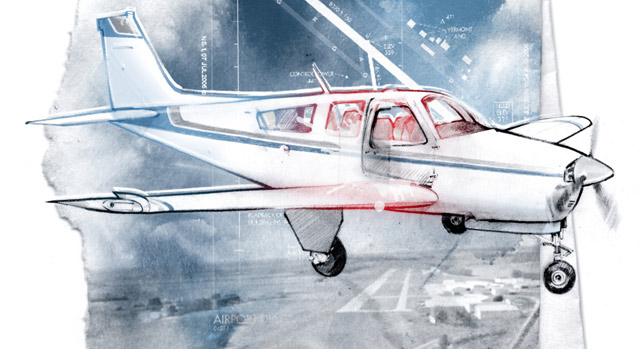
Illustration by Patrick Vale
On a cold, clear New Year’s Eve morning I pulled my Bonanza out of its hangar at Chicago Executive Airport (PWK). Although the TAF was calling for IFR by early afternoon, the 20-minute trip to my mechanic at nearby Lake in the Hills Airport (3CK) at 9 a.m. was a piece of cake.
With two to three hours remaining before IMC moved in, I departed Lake in the Hills and decided to take an 11-minute detour to top off the tanks with cheaper fuel at Burlington Municipal Airport (BUU). The sky was thinly overcast at 6,000, and the 10 degrees Fahrenheit temperature seemed a little chillier as the wind picked up to eight to 10 knots. I wore a long-sleeve shirt, dual-layer nylon jacket, and a vest. I even had a pair of light cotton gloves in the cockpit, although I could never imagine why I would use them.
The runway at Burlington was visible as a white line of a different shade than the rest of the field, as it had not been plowed since the morning’s snow dusting. In my GUMPF check (gas, undercarriage, mixture, prop, and flaps), I had already dropped the gear, verified three green, and deployed approach flaps.
Then came the giant bang! followed immediately by turbulent, rushing, and very cold air into the cockpit as the passenger-side door popped open.
My CFII had popped the door on takeoff the previous fall to demonstrate just how disorienting that is. At 100 knots, it is like a tornado and louder than anything.
My first thought was Wow, OK, that’s not so bad. I’ve done this before. Just land the airplane. Aviate, navigate, communicate. Verifying that all other gauges were reading properly, I returned to the simple task of completing the landing. But that wouldn’t happen for almost 10 more minutes—10 very long, very cold, very angst-ridden minutes.
I had lost sight of the airport, let alone the runway. I had drifted away from the airport and lost my parallel tracking of the runway by almost a mile—and 30 degrees. It was as if I were departing the pattern on a 45 on downwind, when I should have been turning base. I turned right to begin the base leg, and discovered that while the Garmin 530 said “Your little airplane icon and the airport dot are real close,” that did little to help me track into the runway and my base leg. I had lost spatial orientation.
I was just over 500 feet agl, 90 knots (typical for base leg in this airplane), but no longer on a standard base leg. Aborting the immediate landing was obvious, since I no longer had the airport in sight.
And I was cold! There was wind in that cockpit—turbulent, swirling wind with no instructor in the right seat to block the stream of frigid air. Or to keep the seatback upright, as the turbulence got behind it and slammed it forward into the yoke. The frigid air turned my breath visible and my hands numb on controls that needed fine motor skills. The gloves were hanging just inches from me, but I was not about to let my hands off the controls to don them.
So I drifted out of the pattern and decided to make a running start back toward the airport, rather than try to set up for a very short base/final leg. Unfortunately, I did not have extended centerlines activated on ForeFlight Mobile on the iPad, or on the Garmin 530. Pointing the little airplane icon toward the blue airport dot did not line me up with the runway, and I was again unable to find the snowy airport among the surrounding farmlands.
I could not keep this up much longer. I was able to engage extended centerlines and track up on ForeFlight. I was almost three miles from the airport. Now I had a plan: Intercept the extended centerline with the track vector stub, and follow it in for a straight-in approach, bearing runway heading.
Training came back to help me. Landing checklist: GUMPF. I verified the three green landing lights. Mixture still full rich. Flaps. One notch was still in and I put in the second notch when I saw the white runway appear over the nose. Then prop full forward. Airspeed, altitude, pitch, and power. The landing was pretty nice. The snow probably deserves credit for much of the touchdown. “Burlington traffic, Bonanza Five-Six-Seven-Eight, clear of Runway 29, Burlington,” were the nicest words I heard myself say all week.
It would be simplistic to say the lesson I learned was just “always double-check the door before takeoff.” For me, this was a lesson on winter flying. Cold is your enemy, and a very formidable one at that. I did have gloves in the cockpit, and I was dressed adequately for extended cold weather, even if I wasn’t zipped and bundled in the cockpit during flight. I will always be more prepared—mentally and physically—for exposure to cold when flying, even as I hope to never be in such a position again.
Henry Fiorentini of Lincolnshire, Illinois, is vice president of the Midwest Bonanza Society. He is working on an instrument rating and has about 500 hours, most in his Bonanza and Beech Sundowner.
Web: www.aopa.org/pilot/never_again


